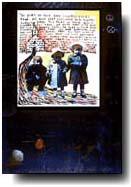 The
library world feels depaysé
today, and rightly so. Both of its physical entities, the buildings and
the books they contain, can no longer form the basis for planning. And
the curatorial function has metamorphosed, to borrow a phrase from an archivist
acquaintance, "from curatorial to
interpretive." Librarians of electronic
information find their job now a radically rhetorical one - they must consciously
construct human attention-structures rather than assemble a collection
of books according to commonly accepted rules. They have, perhaps unwillingly,
found themselves transported from the ancillary margin of the human sciences
to their center. If this be so - and can it be doubted? - how should we
train librarians, much less plan the building where they will work? Maybe
the novelty of the challenge explains why the number of master of library
science degrees awarded in the last ten years has fallen by 50 percent.
What happens when text moves from page to screen? First, the digital
text becomes unfixed and interactive. The reader can change it, become
writer. The center of Western culture since the Renaissance - really
since the great Alexandrian editors of Homer - the fixed, authoritative,
canonical text, simply explodes into the ether.
The
library world feels depaysé
today, and rightly so. Both of its physical entities, the buildings and
the books they contain, can no longer form the basis for planning. And
the curatorial function has metamorphosed, to borrow a phrase from an archivist
acquaintance, "from curatorial to
interpretive." Librarians of electronic
information find their job now a radically rhetorical one - they must consciously
construct human attention-structures rather than assemble a collection
of books according to commonly accepted rules. They have, perhaps unwillingly,
found themselves transported from the ancillary margin of the human sciences
to their center. If this be so - and can it be doubted? - how should we
train librarians, much less plan the building where they will work? Maybe
the novelty of the challenge explains why the number of master of library
science degrees awarded in the last ten years has fallen by 50 percent.
What happens when text moves from page to screen? First, the digital
text becomes unfixed and interactive. The reader can change it, become
writer. The center of Western culture since the Renaissance - really
since the great Alexandrian editors of Homer - the fixed, authoritative,
canonical text, simply explodes into the ether.



 The
library world feels depaysé
today, and rightly so. Both of its physical entities, the buildings and
the books they contain, can no longer form the basis for planning. And
the curatorial function has metamorphosed, to borrow a phrase from an archivist
acquaintance, "from curatorial to
interpretive." Librarians of electronic
information find their job now a radically rhetorical one - they must consciously
construct human attention-structures rather than assemble a collection
of books according to commonly accepted rules. They have, perhaps unwillingly,
found themselves transported from the ancillary margin of the human sciences
to their center. If this be so - and can it be doubted? - how should we
train librarians, much less plan the building where they will work? Maybe
the novelty of the challenge explains why the number of master of library
science degrees awarded in the last ten years has fallen by 50 percent.
What happens when text moves from page to screen? First, the digital
text becomes unfixed and interactive. The reader can change it, become
writer. The center of Western culture since the Renaissance - really
since the great Alexandrian editors of Homer - the fixed, authoritative,
canonical text, simply explodes into the ether.
The
library world feels depaysé
today, and rightly so. Both of its physical entities, the buildings and
the books they contain, can no longer form the basis for planning. And
the curatorial function has metamorphosed, to borrow a phrase from an archivist
acquaintance, "from curatorial to
interpretive." Librarians of electronic
information find their job now a radically rhetorical one - they must consciously
construct human attention-structures rather than assemble a collection
of books according to commonly accepted rules. They have, perhaps unwillingly,
found themselves transported from the ancillary margin of the human sciences
to their center. If this be so - and can it be doubted? - how should we
train librarians, much less plan the building where they will work? Maybe
the novelty of the challenge explains why the number of master of library
science degrees awarded in the last ten years has fallen by 50 percent.
What happens when text moves from page to screen? First, the digital
text becomes unfixed and interactive. The reader can change it, become
writer. The center of Western culture since the Renaissance - really
since the great Alexandrian editors of Homer - the fixed, authoritative,
canonical text, simply explodes into the ether.
